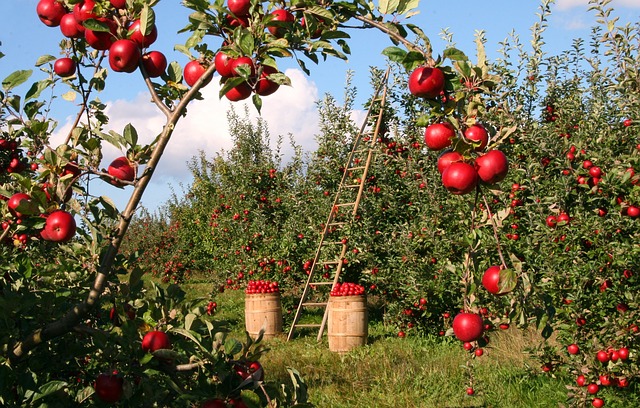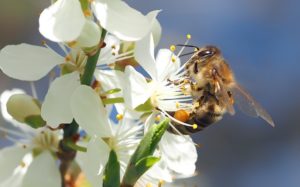10 Must Have Tips for Growing a Fruit Tree

When I planted my first fruit tree several years ago, I had no idea of all the little things that went into maintaining a fruit tree.
I had seen citrus trees all over the Phoenix area and just assumed you stick them in the ground, give them a little water, and pick fruit.
Well, I quickly discovered there is more to it than that.
I had the chance to tour a local gardener’s backyard which opened my eyes to all the possibilities when it came to growing fruit trees in a hot, dry climate.
He was growing hundreds of different kinds of fruit trees, including tropical fruit trees, all on a small urban lot.
This sparked my passion for growing fruit trees and I quickly began devouring any information I could find related to various fruit trees and how to grow them.
Here are some of the basic things I wish I’d known when I planted those first few fruit trees.
Need for Cross-Pollination
In my guide for growing plum trees, I mentioned my ignorance on this subject when I planted my first plum tree.
I had no idea that some types of fruit trees required a second variety to produce fruit.
I was always under the impression that as long as there were bees, there would be fruit.

Chill Hours
This is key when growing in an area that is limited on chill hours. A chill hour is considered hours below 45 degrees Fahrenheit.
Many stone fruit trees require a certain number of chill hours during winter dormancy for the tree to produce fruit that upcoming season.
The average amount of chill hours in my area is between 300-400 hours. It’s important to get fruit trees with low chill hour requirements in our area.
Planting in Clay Soil
I wrote a detailed post here about amending clay soil for planting fruit trees. When I planted my first fruit tree, I basically just dug a hole, dropped the tree in, re-filled with the native soil, and watered.
Through observations of my own experiences over the years, talking with other gardeners, and researching, I’ve gained a better understanding about working with clay soil.
I’ve learned a lot about what our soil is lacking, some of the pros of clay soil types, what a healthy soil is all about, and how to improve clay soil.
Micro-Climates
When you live in an environment that has extreme conditions, you have to plan accordingly.
Just because a label on a fruit tree from a big box store says something, it doesn’t mean that it’s optimal for your environment.
A typical full sun plant works great in full sun in the Midwest, but good luck putting that plant in full sun in the desert. Read my post, Importance of Microclimate for Backyard Gardening.
Mulching
I had no idea of the importance of mulching. I used some mulch around my fruit trees when I first started planting my fruit trees, but I thought is more for aesthetics.
I’ve since learned that mulch is hugely important for retaining moisture, as well as helping to create a living soil. As mulch breaks down, it creates humus and organic matter that our soil is lacking.
Since adding mulch consistently to my fruit trees and surrounding areas, I’ve seen a major increase in microbes, bugs, and worm life that help to create healthy soil.

High Heat Objects
In our desert climate, we are already dealing with extremely hot temps, let alone planting near things that can radiate heat.
Things like block walls that are commonly found in our urban backyards can deflect a lot of heat, so planting up against a wall that is getting all day sun can create an oven for your tree.
Landscape rocks are attractive and commonly used in desert landscapes, but it also creates more heat radiation for your fruit trees.
High-Density Planting
I went into backyard fruit tree growing with an orchard grower’s mentality. Many things you read about planting fruit trees instruct you to plant 20 feet apart or more.
This is great when planting large amounts of fruit trees for commercially producing fruit on huge plots of land, but for the backyard grower, there is a better way.
The first couple fruit trees I planted were in a neat row a large measurable distance apart like what I read to do. After doing that garden tour, it opened my eyes to the concept of high-density planting.
High-density planting consists of a couple different concepts. One is to keep trees smaller through pruning methods to allow for more fruit trees in a small space.
Two, that in nature trees grow close together and not in neat orderly rows with a specified distance apart.
Feeding
Trees need more than just water. Feeding is as important to trees as it is for humans. Without the proper nutrients, fruit trees can deteriorate in a hurry.
Fruit trees need a lot of nutrients to generate the energy needed to produce high-quality fruits. There are many different types of fertilizers for trees and methods of feeding.
Here are the products that I utilize for success and recommend.
Roots need Oxygen
It’s important for the root flare to be exposed so the tree roots are able to breathe. The root flare is where the roots start off the trunk.
If you bury this flare, it can cause problems for the tree. Likewise, too much water doesn’t allow the roots to get the oxygen, drowns the roots, and leads to diseases like rot.

Don’t Panic
This is a common thing I see with beginner fruit tree growers and remember doing it myself. Anytime a leaf would turn yellow or I’d see a crispy leaf, I’d begin to freak out.
I’d instantly think I needed to do something for the tree or that I wasn’t doing something right. I’d start second guessing if I was over or under watering, maybe I was feeding too much or too little, but I always thought something was wrong.
I’ve learned that in an extreme climate, trees aren’t always going to look lush and green. Yes, sometimes those signs are signs that something is wrong, but a lot of the time, if you are caring for the tree properly, it’s just a normal part of the trees cycle.
In summary, getting that first fruit tree and visualizing all those future harvests is exciting. Utilizing these strategies will help reduce mistakes when getting started. I hope these tips will be helpful for the beginner fruit tree growers out there to excel in the backyard orchard.
Please comment below on anything that you enjoyed or found helpful from this post.

I have been growing what you are growing plus more for 40 years. Call me @ (805) 231 9832 to learn more.